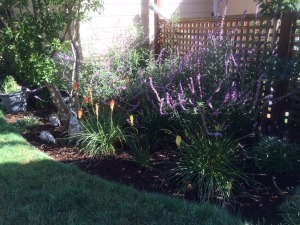I think it is safe to say the mandatory cutbacks have really gotten our attention. Whether in my role as a Master Gardener, meeting with my clients in the real estate world, or just out for coffee or dinner, nearly every conversation is about the drought and how we — and our landscapes — are going to survive while meeting the restrictions.
There are 13 water retailers in Santa Clara County alone and dozens more in the Bay Area. They have all implemented different rules and regulations in order to meet the statewide mandate of a 25 percent reduction.
Some are requiring residents to cut back 30 percent of their monthly 2013 usage. Some allow only set units of water per month, regardless of the size of home, property or number of folks living there. Most have also limited outdoor irrigation to just twice per month.
Most of our trees, shrubs and even those water-guzzling lawns will survive with that amount of water. And, of course, native and Mediterranean landscapes can survive and even thrive with much less.
You may be considering changing your landscaping to reduce water, but now is not the best time to plant. That’s in the fall. Now is the time to do your research and planning.
There are thousands of great water-wise habitat options for every inch of your yard. Here are a few favorites:
TREES
Redbud, crabapple, crepe myrtle, madrone, Washington hawthorn
SHRUBS
Manzanita, ceanothus, salvia, lavender, verbena, Oregon grape, currant, pineapple guava, toyon
FLOWERS
Cosmos, serpentine columbine, sunflower, yarrow, zinnia, monkey flower, penstemon
HERBS
Rosemary, oregano, thyme, sage, lemon balm, chives
LAWN ALTERNATIVES
Carex pansa/texensis, creeping red fescue, junegrass, creeping thyme; native bentgrass and native mow-free, both from Delta Bluegrass.
If you are going to make the move this fall, stop watering your lawn now, as well as the shrubs, trees and flowers you intend you remove and replace. Use this time to plan and prepare the areas that you are going to redo and wait until fall to start planting. All plants, including low-water ones, need to be irrigated for the first two or three years until they are established.
We are blessed to live in such a beautiful region. Not only do we have the responsibility to preserve it, we have a fabulous opportunity to make it better. Replacing lawns, plants that are past their prime and ones that weren’t meant to be here with gorgeous, water-wise options that support our local birds, bee, bugs and butterflies can transform your standard landscape into a thriving, backyard oasis.
For rebate programs and more ways to save, contact your local water retailer.
Rebecca Jepsen is a Santa Clara County Master Gardener.


 Being an avid gardener, born and raised in Indiana, I feel incredible blessed to live in sunny California & be able to grow my own food all year-round! I write a monthly garden column for the San Jose Mercury News & am constantly striving for tips & ideas on how to live a little more gently in regards to ourselves, our planet & each other – basically sustainability we can live with! As a
Being an avid gardener, born and raised in Indiana, I feel incredible blessed to live in sunny California & be able to grow my own food all year-round! I write a monthly garden column for the San Jose Mercury News & am constantly striving for tips & ideas on how to live a little more gently in regards to ourselves, our planet & each other – basically sustainability we can live with! As a 



